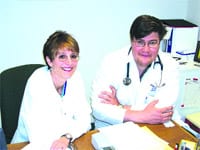Questions About Cancer – Some Steps to Reduce Your Risk of Getting the Disease
Q. Cancer runs in my family. Is there any truth to the fact that you can prevent cancer?
A. Many cancers are associated with obesity — breast cancer (particularly in older women), uterine, kidney, esophagus, colon, and rectum. One study suggests that 4{06cf2b9696b159f874511d23dbc893eb1ac83014175ed30550cfff22781411e5} of cancers in men and 7{06cf2b9696b159f874511d23dbc893eb1ac83014175ed30550cfff22781411e5} in women are attributable to obesity.
While there is a clear relationship between body weight and cancer, the lower your body weight, then the lower your chances of cancer. However, only a few studies have explored reducing cancer risk by losing weight, particularly for breast and colorectal cancer, and its association with improvement in cancer rates. Patients who have undergone weight-loss or bariatric surgery also appear to have lower cancer rates.
Q. To what extent does eating healthy and exercising play in helping to prevent cancer?
A. Exercise has been shown to be associated with lower cancer rates for breast, uterine, colon, and rectum, and even lung cancer. The amount of exercise varies, but even moderate exercise — three to five hours of walking at an average pace — will lead to lower rates of breast and colorectal cancer. Active people have a 20{06cf2b9696b159f874511d23dbc893eb1ac83014175ed30550cfff22781411e5} to 40{06cf2b9696b159f874511d23dbc893eb1ac83014175ed30550cfff22781411e5} (sometimes more) reduction in cancer risk compared to more sedentary individuals, regardless of their weight.
As a society, we eat too few fruits and vegetables, with most Americans falling short of the long-recommended dietary guidelines from the National Cancer Institute. Diet is far more complicated an issue to study than is exercise. Food intake is complex, and very rooted in cultural norms. Eliminating one type of food more associated with cancer often results in its replacement with other foods that may have other adverse health effects.
Q. What other lifestyle changes would you recommended to help prevent cancer, and can they really make a difference?
A. Of course, tobacco usage is the major avoidable cause of cancer and outweighs many other factors in our control. For example, while a World Health Organization (WHO) alert not too long ago on consuming processed meats estimated an 18{06cf2b9696b159f874511d23dbc893eb1ac83014175ed30550cfff22781411e5} increase in colon cancer, in comparison, cigarette use is associated with a 2,500{06cf2b9696b159f874511d23dbc893eb1ac83014175ed30550cfff22781411e5} increase in lung cancer, as well as many other cancers and health problems. So, if you are using tobacco products, the first priority is to stop, and stop permanently. Your healthcare provider can help with aids that can assist in the quitting process. Alcohol intake is also associated with a number of cancers, including breast and esophageal cancers.
It’s also important for you to avoid excess sun exposure. This is particularly important for young people, as the risk of melanoma — the most deadly form of skin cancer — appears to be highly impacted by sun exposure, especially with sunburns before adolescence. But older people continue to have increased risk for all skin cancers with ongoing exposure. So, whatever your age, you should practice sun-smart behaviors, such as avoiding peak sunlight hours, seeking shade, and using sun-blocking products.
Q. Is it ever too late for me to benefit from lifestyle changes?
A. Any reduction in your exposure to risk factors is valuable. For example, quitting smoking significantly reduces the risk of lung and other cancers over time, and even patients with advanced lung and head and neck cancer can enjoy significant survival benefits by discontinuing tobacco use. As a result, you should make every effort to quit tobacco use if you smoke, exercise more, lose weight if you are overweight or obese, and reduce your alcohol consumption. If you can only do one or two of these, then eliminating tobacco and exercising more are the most important.
Q. I understand that people with a family history and certain inherited genes are known to have a higher risk of certain cancers. What is the best way for me to deal with this?
A. This is a complicated area that requires a sophisticated program. Cancer is a common disease, and rare is the family without any cancers. However, research has demonstrated a number of genes associated with familial or inherited cancer syndromes. Seeking help with programs, such as Baystate Medical Center’s Family Cancer Risk Program available at the D’Amour Center for Cancer Care, allows trained genetic counselors and physicians to determine your risk, the appropriate tests to perform, and the best approaches for management.
Q. What about my environment?
A. We are almost inundated with news reports of epidemiological studies — the study of health in populations to understand the causes and patterns of health and illness — suggesting a variety of risks associated with the development of different cancers. As a result of the nature of these studies, conflicting data can arise, and often-suspicious clusterings of cancer diagnoses — suggesting a common exposure, such as water contamination and industrial pollutants — cannot be attributed to a single cause. An additional reason for this frustration is that, while cancer in general is common, specific cancers, such as lung and colon cancer, may not be frequent enough to show a clear connection.
We do have clear connections to factors such as tobacco and alcohol use, obesity, dietary intake, and sedentary lifestyle that can be altered. No one will suggest that these lifestyle changes are easy — this column would not be necessary if they were — but even small changes can make a difference. v
Dr. Wilson C. Mertens is vice president and medical director, Cancer Services, Baystate Regional Cancer Program, Baystate Health.


